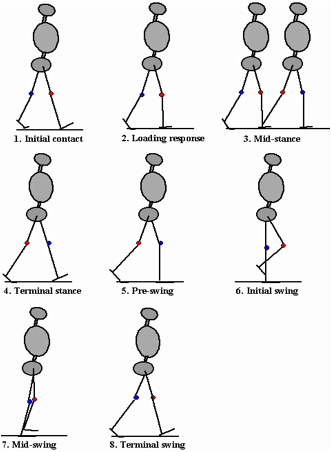Often used interchangeably with locomotion. Refers to a manner of locomotion (e.g., shuffling gait as in Parkinson‚was disease). Typically, a gait cycle is characterized by a stance phase (when a foot is in contact with the ground) and a swing phase (when the foot is lifted until the heel strikes the ground again). As shown in the figure below, there are four sub-phases for the stance phase (1-4), and a similar number for the swing phase (5-8). There are three main tasks required to accomplish a gait cycle: weight acceptance involving transfer of body weight onto the limb that has just completed the swing phase (1-2), single leg support during which one leg supports the whole body weight (3-5), and limb advancement in which the foot is lifted from the ground (5-8). All 8 sub-phases of the gait cycle are typically only achieved by 10 years of age. Three main categories of abnormal gait are distinguished: ataxic gait (unsteady walking with a wide base of support, and feet pointing outward), antalgic gait (adjusting limb movements with short stance phases so as to avoid pain in the weight-bearing structures after injuries to an ankle, knee or hip), and apraxic gait (an in ability to carry out normal, purposeful movements of the limbs in the absence of disease or impairments).
